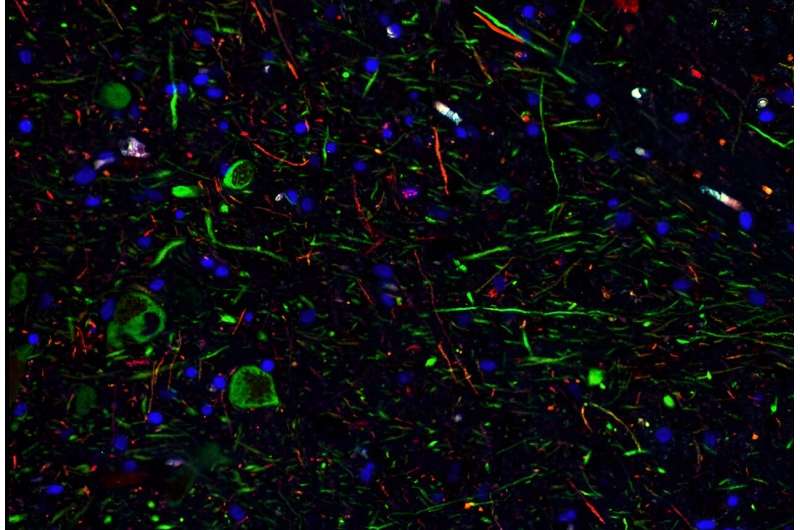This article has been reviewed according to Science X's editorial process and policies. Editors have highlighted the following attributes while ensuring the content's credibility:
fact-checked
peer-reviewed publication
trusted source
proofread
SARS-CoV-2 can infect dopamine neurons causing senescence

A new study reported that SARS-CoV-2, the virus that causes COVID, can infect dopamine neurons in the brain and trigger senescence—when a cell loses the ability to grow and divide. The researchers from Weill Cornell Medicine, Memorial Sloan Kettering Cancer Center, and Columbia University Vagelos College of Physicians and Surgeons suggest that further research on this finding may shed light on the neurological symptoms associated with long COVID, such as brain fog, lethargy, and depression.
The findings, published in Cell Stem Cell on Jan. 17, show that dopamine neurons infected with SARS-CoV-2 stop working and send out chemical signals that cause inflammation. Normally, these neurons produce dopamine, a neurotransmitter that plays a role in feelings of pleasure, motivation, memory, sleep, and movement. Damage to these neurons is also connected to Parkinson's disease.
"This project started out to investigate how various types of cells in different organs respond to SARS-CoV-2 infection. We tested lung cells, heart cells, pancreatic beta cells, but the senescence pathway is only activated in dopamine neurons," said senior author Dr. Shuibing Chen, director of the Center for Genomic Health, the Kilts Family Professor Surgery and a member of the Hartman Institute for Therapeutic Organ Regeneration at Weill Cornell Medicine. "This was a completely unexpected result."
Determining how SARS-CoV-2 impacts different cells
Previously, Dr. Chen led the effort to generate multiple cell types from human stem cells and tested them to see which ones SARS-CoV-2 could infect. This allowed the researchers to survey the spectrum of tissues that might be infected during COVID, which has a diverse array of symptoms in different patients. They also studied autopsy samples from patients infected with the virus to confirm their observations from the lab-grown cells.
Surprisingly, they found that a small percentage of dopamine neurons exposed to SARS-CoV-2 were infected, approximately five percent. "The infection rate of dopamine neurons isn't as high as lung cells, the virus's main target, but even a small population of infected cells can potentially have a severe effect," said Dr. Chen.
Interestingly, not all neuronal cell types were vulnerable to viral infection. The researchers observed that cortical neurons were not permissive to SARS-CoV-2 infection under identical experimental conditions.
Protecting dopamine neurons
In this paper, the researchers used transcriptional profiling to identify how SARS-CoV-2 infection modified gene activity and the resulting changes in the way cells behaved. "We discovered that only dopamine cells had the senescence pathway activated," said Dr. Chen. In stark contrast, the genes in the senescence pathway were not significantly turned on with SARS-CoV-2-infected lung organoids, pancreatic cells, liver organoids, or heart cells.
The researchers found that the gene signatures—the unique pattern of gene activity—from the infected lab-grown dopamine neurons and the dopamine neurons from COVID autopsy samples were the same. This included genes that triggered chemical signals for inflammation.
Next, they looked for ways to protect the neurons to reduce the risk of neurological defects when a patient is infected by the virus.
The researchers tested drugs already marketed for various conditions to find one that either prevented SARS-CoV-2 infection or rescued infected dopamine neurons from senescence. The screen identified three drugs that blocked SARS-CoV-2 infection, thereby preventing the dopamine cells from senescence: riluzole (treats ALS or Lou Gehrig's disease), metformin (treats diabetes), and imatinib (treats cancer). Further study on these drugs may lead to a way to prevent the virus's attack on the brain.
Though most people are exposed to COVID, only certain individuals will be impacted since many factors are involved in the risk for neurological symptoms, including severity of the disease and genetics. Human population studies are exploring this aspect further.
While the clinical relevance of these findings is still unclear, since dopamine neuron senescence is a hallmark of Parkinson's disease, the researchers suggest that long COVID patients should be monitored for an increased risk of developing Parkinson's-related symptoms. To date, Parkinson's symptoms have not been overly reported in population studies.
More information: Liuliu Yang et al, SARS-CoV-2 infection causes dopaminergic neuron senescence, Cell Stem Cell (2024). DOI: 10.1016/j.stem.2023.12.012



















